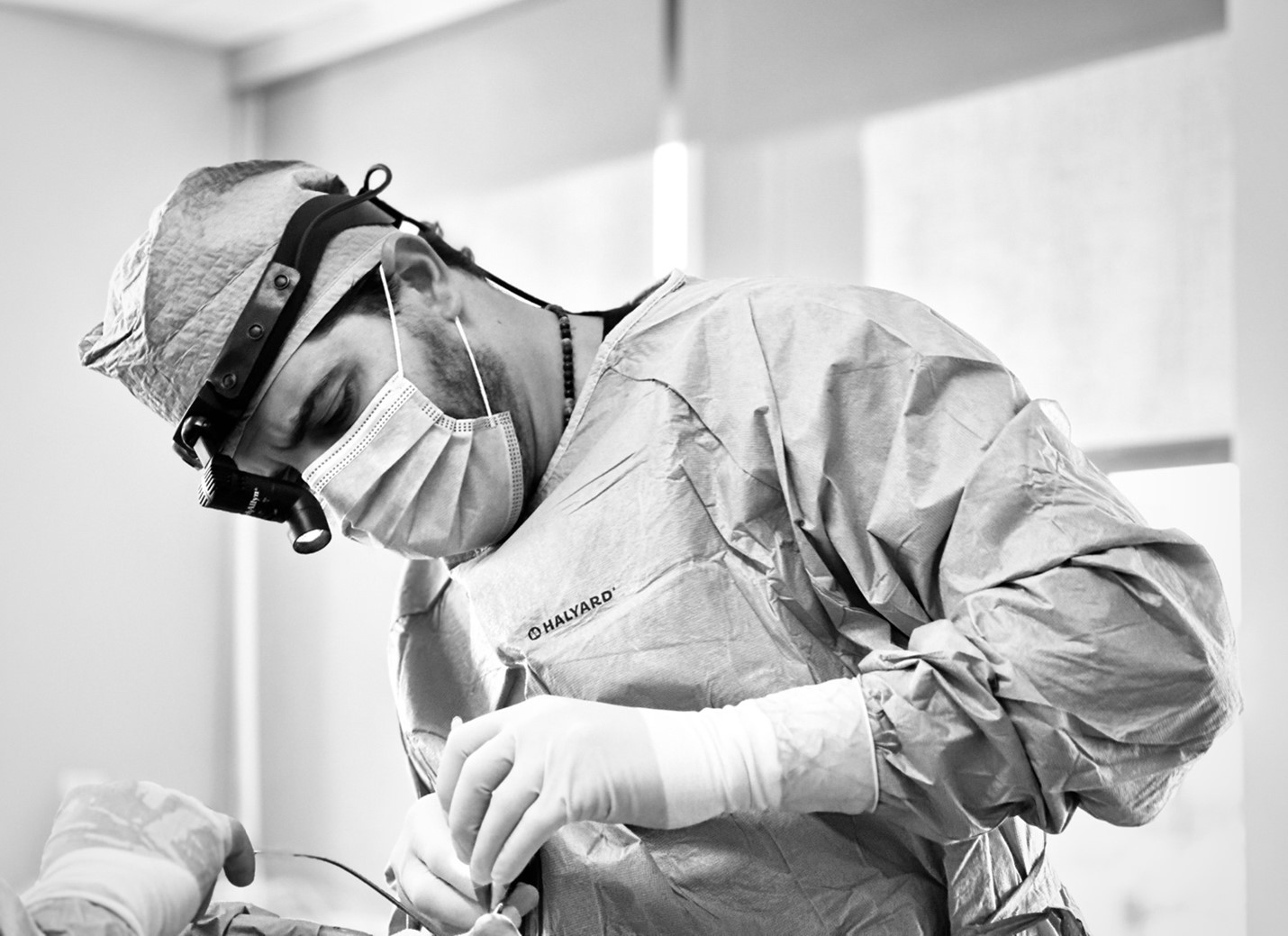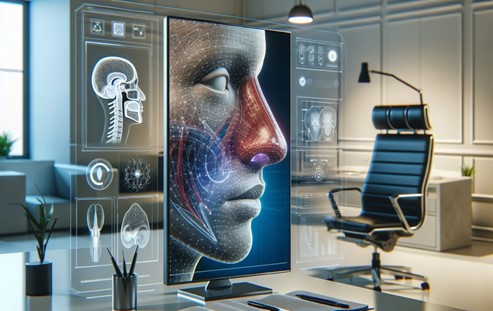Dr. Zahi Abou Chacra graduated from McGill University School of Medicine and University of Montreal in Otolaryngology – Head and Neck Surgery. Dr. Chacra is double board-certified by the Royal College of Physicians and Surgeons of Canada, as well as the American Board of Facial Plastic and Reconstructive Surgery. He also works as an Assistant Professor in the Department of Surgery at the University of Montreal. In the following article, Dr. Abou Chacra delves into the profound impact of 3D imaging and virtual consultations on the practice of rhinoplasty, unraveling how these technological advancements are reshaping the preoperative experience, enhancing communication between surgeons and patients, and ultimately, elevating the art and science of nasal refinement to unprecedented heights.
 Rhinoplasty has seen a remarkable transformation with the integration of cutting-edge technology. These innovations are revolutionizing the way surgeons like Dr. Zahi Abou Chacra plan and perform procedures, leading to more accurate, customized, and successful outcomes. In this article, we delve into the impact of technology on rhinoplasty, specifically, exploring the nuances of 3D imaging and the benefits of virtual consultations.
Rhinoplasty has seen a remarkable transformation with the integration of cutting-edge technology. These innovations are revolutionizing the way surgeons like Dr. Zahi Abou Chacra plan and perform procedures, leading to more accurate, customized, and successful outcomes. In this article, we delve into the impact of technology on rhinoplasty, specifically, exploring the nuances of 3D imaging and the benefits of virtual consultations.
Dr. Zahi Abou Chacra, Rhinoplasty Expert, explores the Impact of 3D Imaging in Cosmetic Rhinoplasty Surgery

3D imaging in cosmetic and aesthetic rhinoplasty makes it evident that this technology is not just a tool for surgeons; it is a technological force that enhances the overall surgical experience for both medical professionals and patients alike.
The Process of Creating a Digital Nose Profile
Dr. Chacra, who is the Medical Director of Clinique 7, in Montreal, Canada, says that traditionally, rhinoplasty consultations relied mostly on verbal communication and 2D images.
The introduction of 3D imaging has elevated the consultation process by allowing surgeons like himself to create a more precise digital profile of the patient’s nose. This involves capturing high quality images of the patient’s face from various angles, which are then meticulously reconstructed to form a comprehensive 3D model. This digital facial profile serves as the foundation for personalized surgical plans.
While these technological advances are part of a new, exciting wave of development and progress in the medical field, the importance of a thorough physical exam and the face-to-face, in-person rapport that happens between patients and surgeons cannot be discounted.
Both technologies, and the human component behind the use of the technology is what ultimately leads to better outcomes and allows for more thorough surgical planning. The way these tools are used during the consultation process (and even in post-operative settings) are as important as the knowledge, skills and abilities of the surgeon utilizing them.
Enhancing Surgical Accuracy with 3D Models
Surgical precision is paramount in rhinoplasty, and 3D models have become invaluable tools in achieving this goal. Dr. Zahi Abou Chacra can examine a high-resolution, three-dimensional representation of the patient’s nasal structure, enabling him to plan and execute procedures with unprecedented accuracy. The use of 3D models during the consultation and patient evaluation process serves as a visual guide, reducing the margin of error and contributing to optimal outcomes.
Virtual Reality Previews: Setting Realistic Expectations
Dr. Chacra explains that one of the most impactful aspects of 3D imaging in rhinoplasty is the integration of virtual reality previews. This innovative feature allows patients to immerse themselves in a simulated version of their potential post-surgery results. By offering a realistic preview to his patients, Dr. Zahi Abou Chacra says virtual reality helps his patients to set reasonable expectations, fostering a collaborative decision-making process between the surgeon and the patient. This not only reduces the likelihood of dissatisfaction post-operatively, but also empowers patients by providing them with a better understanding of the proposed changes to the appearance of their nose.
Benefits of 3D Imaging in Rhinoplasty
Zahi Abou Chacra also notes that the benefits of 3D imaging in rhinoplasty extend far beyond the technical aspects of surgery. Precision and accuracy, enhanced patient understanding, and the ability to customize and visualize possible surgical outcomes contribute to a more transformative and patient-centric approach. Dr. Chacra is known for devoting himself to the quality of his patients’ care, as well as delivering exemplary surgical results.
Precision and Accuracy
Precision and an eye for symmetry are the cornerstones of any successful rhinoplasty procedure. 3D imaging emerges as a key player in achieving unparalleled accuracy when it comes to certain aspects of cosmetic rhinoplasty surgery.
Dr. Abou Chacra explains that surgeons can meticulously plan and execute each step of cosmetic rhinoplasty surgery by examining a detailed, three-dimensional representation of the patient’s nasal structure.
This precision minimizes the risk of unexpected outcomes and ensures that the surgical plan aligns with the patient’s unique anatomical characteristics. As a result, the integration of 3D imaging elevates the overall accuracy of what is possible during cosmetic rhinoplasty, instilling confidence in both surgeons like Dr. Chacra, and his patients.
Enhanced Patient Understanding

Patients can actively engage in the decision-making process and conversation around their personalized rhinoplasty surgery as they witness a realistic preview of their potential post-operative appearance. Zahi Abou Chacra says that this enhanced understanding not only improves conviction in the highly-personalized surgical plan but also promotes a more collaborative relationship between him and his patients.
Customization and Visualization
Every nose is intrinsically unique, and 3D imaging allows for a level of customization and visualization that was previously less detailed. Rhinoplasty Surgeons like Dr. Zahi Abou Chacra can tailor their approach to the individual anatomy of each patient, ensuring that the proposed changes align with the patient’s aesthetic goals.
Virtual Consultations: Bridging the Gap Between Surgeon and Patient when it comes to Cosmetic Rhinoplasty
 As we explore the role of virtual consultations in rhinoplasty, it becomes evident that this technological advancement not only increases accessibility to patients, but also prioritizes patient comfort. Breaking geographical barriers, offering convenience, and maintaining a patient-centric approach through technology redefines the traditional dynamics of surgeon-patient interactions, setting new standards for the future of cosmetic rhinoplasty consultations.
As we explore the role of virtual consultations in rhinoplasty, it becomes evident that this technological advancement not only increases accessibility to patients, but also prioritizes patient comfort. Breaking geographical barriers, offering convenience, and maintaining a patient-centric approach through technology redefines the traditional dynamics of surgeon-patient interactions, setting new standards for the future of cosmetic rhinoplasty consultations.
Breaking Geographical Barriers
Traditional healthcare often posed geographical constraints, limiting patients’ access to renowned surgeons, such as Dr. Chacra. He explains that virtual consultations dissolve these barriers by enabling patients to connect with skilled professionals regardless of their physical location. This not only expands the pool of available expertise but also empowers patients to make informed decisions about their cosmetic rhinoplasty journey. The ability to consult with renowned surgeons from the comfort of their homes has revolutionized the accessibility of quality healthcare in facial plastic surgery.
Convenience and Comfort of Remote Patient Consultation
The convenience offered by virtual consultations is unparalleled, reshaping the patient’s experience when it comes to cosmetic rhinoplasty consultations. Patients can now engage in consultations with top-ranked specialists like Dr. Zahi Abou Chacra from the comfort of their homes, eliminating the need for travel and mitigating associated time and logistical challenges.
This remote approach not only enhances the overall convenience for patients but also allows for more flexibility in scheduling appointments, catering to the diverse needs of individuals seeking all kinds of rhinoplasty procedures, from Cosmetic Rhinoplasty to Revision Rhinoplasty and Ethnic Rhinoplasty.
Maintaining Personalized Care Through Technology
Despite the virtual nature of these consultations, Dr. Zahi Abou Chacra ensures that personalized care remains at the forefront. Surgeons can address individual concerns, discuss treatment plans, and establish a strong doctor-patient relationships through virtual platforms.
An in-person meeting with the surgeon is always necessary prior to any surgery as a physical exam is a requirement for establishing a tailored treatment protocol.
Addressing Concerns: Privacy and Security in Virtual Cosmetic Rhinoplasty Consultations
Zahi Abou Chacra notes that by prioritizing patient data protection, employing secure communication platforms, and building trust through transparent practices, the medical community can embrace virtual interactions as a secure and reliable extension of traditional healthcare delivery.
Ensuring Patient Data Protection
The safeguarding of patient data is of utmost importance in virtual consultations. Rigorous measures are in place to ensure the confidentiality and protection of sensitive information. Encryption protocols are employed to secure data transmission, and stringent access controls are implemented to restrict unauthorized access to patient records.
Compliance with data protection regulations is a non-negotiable aspect, ensuring that patient information remains private and secure throughout the virtual consultation process.
Secure Communication Platforms
Virtual consultations rely on secure communication platforms to facilitate confidential interactions between surgeons and patients. These platforms employ advanced encryption technologies, protecting the integrity of the communication channel.
Dr. Chacra says that by choosing robust and reputable platforms, healthcare providers ensure that patient information is transmitted and stored securely, reducing the risk of data breaches. These secure platforms serve as the foundation for maintaining the privacy and security of all patient data.
Building Trust in Virtual Interactions
Building trust in virtual interactions involves clear communication, transparency, and a commitment to providing high-quality care, even when using technology.
Future Trends in Technology and Rhinoplasty
The interplay of technology and the art of rhinoplasty holds promising prospects, as forthcoming technologies like artificial intelligence and 4D imaging have the potential to radically transform facial plastic surgery and enhance patient outcomes for surgeons like Dr. Zahi Abou Chacra.
Emerging Technologies in Cosmetic Surgery
 Emerging technologies, such as artificial intelligence and 4D imaging, have the potential to further revolutionize facial plastic surgery, including facial reconstructive surgery.
Emerging technologies, such as artificial intelligence and 4D imaging, have the potential to further revolutionize facial plastic surgery, including facial reconstructive surgery.
Artificial intelligence modeling may someday be able to provide an even more realistic visualization of the postoperative results in Cosmetic Rhinoplasty of any given surgeon based on the surgeon’s surgical style and aesthetic penchants.
4D imaging, which combines 3D imaging with the element of time, allows for the visualization of structures in motion. In cosmetic rhinoplasty surgery, 4D imaging can be employed to simulate the potential outcomes of procedures such revision rhinoplasty, providing patients with a better understanding of the results and enabling surgeons like Dr. Zahi Abou Chacra to plan and communicate more effectively.
Predictions for the Future of 3D Imaging and Virtual Consultations
Dr. Chacra explains that as technology continues to advance, 3D imaging and virtual consultations are poised to become even more integral to the rhinoplasty process. The future holds the promise of more sophisticated and realistic 3D models, allowing for an even more accurate representation of the anticipated results.
Virtual reality may evolve to offer immersive and interactive previews, providing patients with a heightened sense of their post-surgery appearance. Predictions also include the integration of augmented reality, enabling surgeons to overlay digital information onto the real-world surgical environment for enhanced precision.
How Technology Will Continue to Shape the Field of Rhinoplasty
Technology’s influence on cosmetic and functional rhinoplasty will persist, shaping the field in multifaceted ways. Surgical robots, guided by AI algorithms, may assist surgeons in executing procedures with unprecedented precision.
Telemedicine platforms may further expand, allowing for remote post-operative monitoring and follow-up care. Dr. Chacra highlights that the continued integration of technology will not only refine surgical techniques, but also contribute to a more personalized and patient-centric approach to rhinoplasty as a discipline, a science, and an art.
Summary
In conclusion, the integration of advanced technology, such as 3D imaging and virtual consultations, has revolutionized the field of both cosmetic and functional rhinoplasty, providing numerous benefits for both surgeons and patients. These innovations have improved surgical accuracy and patient understanding leading to more successful surgeries and greater patient satisfaction. As technology continues to evolve, Dr. Zahi Abou Chacra says that we can expect even more advancements in the field of facial plastic and reconstructive surgery and in both functional and cosmetic rhinoplasty, further shaping the future of this transformative surgical procedure.


